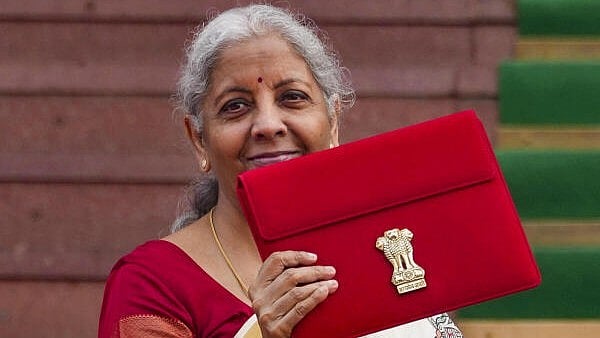
Union Finance Minister Nirmala Sitharaman upon her arrival at the Parliament House complex to present the ‘Union Budget 2025-26’, in New Delhi
Credit: PTI Photo
The 2025 Union Budget has shifted its focus from ‘investment’ to ‘consumption’ to stimulate India’s slowing economy, as the sustained push to fixed investments by the government in the post-Covid-19 recovery phase has not delivered much in terms of improving the private/corporate sector’s investment sentiment.
The overall rate of investment (gross fixed capital formation) has been stagnant near 31% of GDP in the past 10-11 years as compared to 35-36% in FY2008. FY2025 has been quite disappointing for the corporate sector and the primary reason cited was sluggish demand. A slowdown in demand was attributed to various factors like persistently high food inflation, stagnant real wages, a decline in employment in the unincorporated manufacturing sector (as shown by the NSO survey), etc., that have eroded the purchasing power of the household sector.
In response to this, the Budget has announced significant income tax relief measures directed towards the middle-income groups. These measures include ‘nil tax’ for annual income up to Rs 12 lakh, increase in basic exemption limit, doubling of tax deduction limit for senior citizens and rationalisation of tax deducted at source (TDS) regime to improve the ease of compliance.
It’s not clear whether these measures would effectively stimulate ‘consumption’, as the percentage of tax-paying people (even from the middle-income groups) is very insignificant. In India, only 2-3% of adult population are income tax-payers as compared to 78.3% in France, 61.3% in Germany, 59.7% in the United Kingdom, and 50.5% in the United States.
With these tax rebates, the personal income tax receipts are expected to grow by 14.4% in FY2026 as against their growth at 20.3% in FY2025 and 25.4% in FY2024. Instead of these sops, the government should have attempted to widen the tax net to agricultural incomes and incomes from certain individual service providers that are permanently exempted from income tax. Also, it should continue to improve the overall tax compliance.
Moreover, one cannot expect a significant revival in private investment sentiment in today’s global environment marked by tariff wars and the possibility of dumping from China.
With changing focus from consumption to investment, the government has lowered capital expenditure to Rs 10.18 lakh-crore from Rs 11.11 lakh-crore budgeted earlier for FY2025. Also, a higher growth is now expected in the privatisation receipts that looks unrealistic given the experience.
While it is heartening to see that the government is adhering to the fiscal glidepath, the expected debt burden of Rs 181.6 lakh-crore by March 2025 is staggering and will limit the government’s capacity to come out with a sizeable stimulus in difficult economic periods.
Following the long-term vision defined in the Economic Survey for FY2025, the government has prioritised agriculture, the MSMEs, and exports that are the major drivers of ‘job creation’ in India.
For the agriculture sector, the Budget has announced a scheme aimed at benefiting at least 1.7 crore farmers, enhancing the credit limit under kisan credit cards, and a six-year ‘Atmanirbharata’ mission to target self-reliance in major pulses. The Budget has improved the MSMEs’ access to credit and enhanced the credit guarantee cover. However, the banks’ experience with the credit guarantee schemes has not been satisfactory so far.
There has been added emphasis on capacity creation in education and health in line with the Economic Survey’s recommendations. But if one looks at the actual share of spending on different items, the picture that unfolds is quite revealing. The estimated share of interest expenses in total expenditure is nearly 25% while that on subsidies is 8.4% in FY2026. On the other hand, the estimated share of education and health spending in total budgetary expenditure stand at just 2.5% and 1.9%, respectively.
These figures once again underscore the point that the countries laden with debt burden cannot spend enough on developmental objectives. They are forced to prioritise ‘debt service’ over productive investments.
(Rupa Rege Nitsure is a former Chief Economist from the BFSI Sector.)
Union Budget 2025 | Nirmala Sitharaman, as Finance Minister, presented her record 8th Union Budget this time. While inflation has burnt a hole in the pockets of 'aam janata', the Modi govt gave income tax relief for those making up to Rs 12 lakh per year in salaried income. Track the latest coverage, live news, in-depth opinions, and analysis only on Deccan Herald. Also follow us on WhatsApp, LinkedIn, X, Facebook, YouTube, and Instagram.